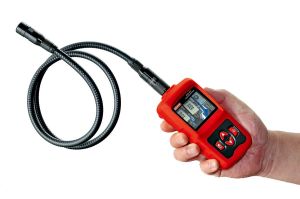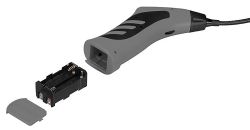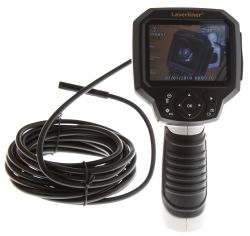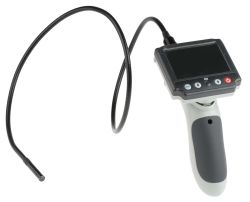Inspection Cameras - A Complete Guide
In this guide we will explore what inspections cameras are
and the best camera to use for different purposes.

In this detailed buying guide, we’ll explain what inspection cameras are and examine some of their various useful applications. We’ll also look at the numerous different types of probe camera and workshop inspection accessories for sale in the UK. Lastly, we will provide you with the support and guidance you need to decide which inspection camera best suits your application.
What are Inspection Cameras?
An inspection camera, sometimes referred to as a snake camera, is a digital camera designed to be small and flexible enough to slide into narrow or otherwise inaccessible spaces.
These instruments’ main purpose is to serve as an exploratory camera. This could be in plumbing applications, medical diagnostics, mechanical repairs, or a wide range of other scenarios. They allow the user to view a live video feed of detailed, close-up images broadcast from locations that otherwise couldn’t easily be seen with the naked eye.
Inspection cameras typically consist of a long, flexible probe or arm, attached to some form of handheld base unit. The miniature camera module itself is mounted on the end of the probe. Some inspection camera kits include a small screen for viewing the live video relay. Others are designed to operate wirelessly, streaming the images they capture to a remote screen (such as on a computer or phone) via Wi-Fi.
What are Inspection Cameras Used for?
Medical
Inspection cameras are widely used in the medical sector, particularly for diagnostics. In surgical contexts, such a tool is often referred to as an endoscope inspection camera.
When designed for use in medical practice and surgery, this type of diagnostic camera allows medical personnel toperform remote video viewing of inaccessible areas of the human body. This could include various organs, body cavities, or the circulatory system.
Mechanical
A mechanic’s camera probe might also be called an engine inspection camera or an auto inspection camera. Again, they provide an opportunity to perform detailed visual inspections of areas that can’t easily be seen from outside the vehicle, without dismantling various complex components. Typical examples might include the insides of engine chambers and fuel tanks.
Flexible camera probes can remotely send back video images from within these various sorts of components and mechanisms. This is extremely handy in all forms of automotive diagnostics and repair. It often means that problems, causes, and potential solutions can be identified without having to fully dismantle the engine or other moving parts first. A digital inspection camera can frequently save both the mechanic and the customer significant amounts of time and money when diagnosing problems or planning fixes.
Property Maintenance
There are countless jobs relating to property maintenance that can benefit from the use of a flexible probe inspection camera. One common use is in diagnosing issues with pipework, plumbing systems, and HVAC systems.
Digital inspection cameras allow problems and fixes to be identified without having to dismantle large sections of ducting. Plumbing inspection cameras are often supplied with extra-long probe reels and have higher IP ratings specifically intended for use in wet environments.
Another important use of these video relay probes in property maintenance and construction work is performing a cavity wall camera inspection. When used as an inside wall camera scope, these products allow the viewer to identify and avoid wiring and stud work.
These devices are also widely used as exploratory cameras when searching for evidence of household pests such as vermin, insects, mould, and other potentially damaging infestations.
Different Types of Inspection Camera
Endoscopes
Many people naturally tend to associate the term ‘endoscope camera’ with medical procedures. Technically speaking, any apparatus referred to as an endoscope will most likely have been designed specifically for use inside the human body.
However, the name is often used as a more general reference to a whole range of inspection camera models and kits, used across many different industries and applications.

The term endoscope broadly denotes a miniature camera (often illuminated) that is mounted on a long, thin and flexible probe. Where they are intended for medical use, endoscopic devices usually comprise one of the smaller diameters of snake camera, down to around 4mm in some cases.
Larger-diameter endoscopic cameras for use in general diagnostic and exploratory applications can come in sizes ranging from 5.8mm up to 80mm and beyond. If an inspection camera is not principally intended for use in medical diagnostics within the human body, the correct term would usually be ‘borescope’ or ‘fibrescope’ (depending on its design and functionality). Generic names such as ‘flexible inspection camera’ are also very common.
USB endoscopes are used increasingly widely for casual, desktop, or fieldwork. Similarly, various types of exploratory cameras can be attached to other handheld devices or screens - such as mobile phones - using a range of adapters and accessories. For example, many people now use inspection cameras for iPhone, or endoscope cameras for Android devices across the world. These are often supported by native camera apps for their respective platforms, typically supplied with the camera kit as a link to a free download.
Borescope Cameras
As outlined above, a borescope is an umbrella term used to refer to any type of inspection camera that isn’t specifically intended for human medical use. There are two main types of borescope inspection camera: rigid and flexible. Rigid borescopes were once the norm, but today flexible products are becoming increasingly popular.
Both rigid and flexible borescopes may be manufactured around a collection of fibre optic or rod-based lenses and image guides. When this is the case, these fibre optic inspection cameras are often referred to as ‘fibrescopes’. However, standard borescopes are usually sufficient for most types of every day, non-destructive industrial or equipment inspections.

When comparing borescopes and endoscopes, there are a few key differences to keep in mind. As endoscopes are principally designed for use in the human body, they tend to be smaller in diameter, and more flexible. Small inspection cameras, sometimes labeled as mini inspection cameras, can also be handy for a wide range of specialist non-medical uses.
The larger borescope often features a brighter light than most endoscopes. It typically offers a broader field of view (anywhere from 50 up to 120 degrees). This field of view is often adjustable via the attached handset or viewing unit. Endoscopes can usually provide greater magnification or zoom than standard borescopes, ideal for more detailed close-up viewing.
Wireless Inspection Cameras
A wireless inspection camera is a generic term used for both borescopes and endoscopes. Regardless of the primary purpose of the instrument, a wireless inspection camera can broadcast its streaming video to a remote screen over Wi-Fi. This can be handy in certain environments and applications, where it’s inconvenient to have footage relayed directly to an attached handheld viewing module via a connected lead.
Bluetooth inspection cameras are another option for remote viewing, using a paired Bluetooth connection to a device rather than a Wi-Fi internet connection.

Today, many models of snake camera offer wireless functionality, including both rigid and flexible borescopes. They allow video feeds to be watched from a laptop, phone, tablet, desktop computer, or other type of LCD monitor. Depending on signal range and strength, this can often take place in an entirely separate location to the camera itself. For this reason, wireless inspection cameras might often be referred to as remote inspection cameras.
For advanced use in hazardous or highly inaccessible areas, specialist inspection cameras are also available that can be steered fully remotely by a handheld control unit.
Flexible Inspection Cameras with Light
You’ll often see flexible inspection camera with light listed as a common feature of many high-quality snake cameras. Illumination is one of the chief benefits of using an inspection camera, along with the ability to adjust your field of view and zoom in on specific areas for closer inspection.
In applications such as plumbing and pipework analysis, auto diagnostics and cavity wall inspection, having a bright light attached to your flexible inspection camera is very important. It helps to achieve a clearer view in many small and often dark spaces, particularly where natural light doesn’t penetrate easily, and detail would otherwise be hard to make out.
Note that most endoscope cameras designed for use in the human body don’t tend to offer quite the same intensity of illumination as standard borescope cameras. However, they may offer increased field of view and zoom capabilities.

Telescopic Inspection Cameras
If you need to inspect areas at height, a telescopic inspection camera may be a suitable option. These work similarly to most standard snake cameras but tend to be mounted on a longer telescopic pole to enable them to reach greater heights. They’re usually rigid, for obvious reasons of stability, although they may feature a flexible head towards the end of the pole where the camera and light are mounted.
What is the Best Inspection Camera?
People often ask, ‘what is the best inspection camera?’ when looking to buy a snake camera for use in a multitude of industrial or equipment inspection scenarios. In truth, the answer is entirely dependent on the specific uses you have in mind. The best inspection camera for electricians, say, will not necessarily be the best option for plumbers, and certainly not for medical or surgical use.
Popular Brands
SKF
Explore the range of inspection cameras from SKF and discover a top-quality device to meet your requirements.
RS PRO
Our own in-house line, RS Pro inspection cameras are held to the same exacting standards as our suppliers to guarantee quality.
Fluke
Browse high-quality inspection cameras from leading brand Fluke and discover the ideal device for your application.
Laserliner
With an extensive range of inspection cameras available, shop devices from Laserliner with RS Components.
